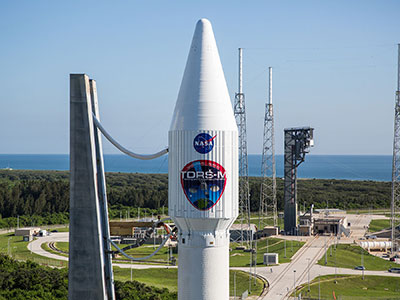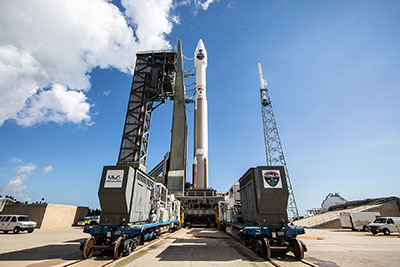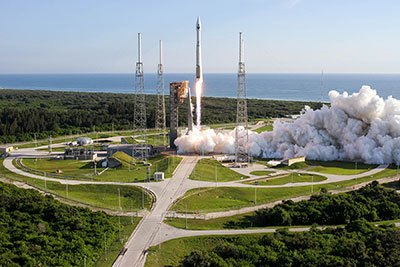In spaceflight, communication is crucial. Whether it's the International Space Station linking to the Mission Control Center at NASA's Johnson Space Center in Houston or interstellar images being transmitted to Earth by the Hubble Space Telescope, the vital link is NASA's Tracking and Data Relay Satellite (TDRS) system.
The latest addition to join this system will be the TDRS-M satellite. It is targeted to lift off atop a United Launch Alliance (ULA) Atlas V rocket from Space Launch Complex 41 at Cape Canaveral Air Force Station in Florida. Liftoff is targeted for a 40-minute launch window opening at 8:03 a.m. EDT on Aug. 18.
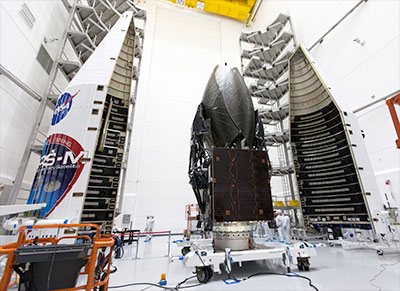
Above: Inside the Astrotech facility in Titusville, Florida, the payload fairing for NASA's Tracking and Data Relay Satellite, TDRS-M, is moved into position to encapsulate the spacecraft. (NASA/Kim Shiflett)
TDRS-M is the final spacecraft of three in the third generation of Tracking and Data Relay Satellites. NASA now is developing the next generation space communications architecture, working to identify creative solutions to meet future mission needs.
Management of Atlas V operations for TDRS-M is managed by NASA's Launch Services Program. LSP oversees the agency’s efforts to commercially provide rockets for specific missions. The team also manages the overall launch effort, including overseeing development and integration of the rocket with the spacecraft.
TDRS-M will allow NASA’s Space Network constellation of satellites to continue supporting space communications well into the 2020s.
According to Kennedy's launch director, Tim Dunn, the network consists of TDRS satellites that transmit data to and from NASA centers on Earth for agency missions and expendable launch vehicles.
"The TDRS constellation has been revolutionary in simplifying space communications," Dunn said. "It is a huge upgrade from when we had to use many ground stations around the world to relay data from space. In addition to Hubble and the space station, TDRS satellites provide critical communication support to the space station, the Hubble Space Telescope and a host of Earth sciences satellites."
Beginning with the flights of Mercury, Gemini and Apollo in the early 1960s, NASA required a worldwide network of tracking stations to stay in touch with orbiting astronauts. By the early 1970s, the agency needed more than 50 spacecraft to supplement ground stations in providing spacecraft communications. Even so, the tracking network only provided contact about 15 percent of the time.
The TDRS project was established in 1973 to determine a way to deliver around-the-clock communications with NASA's most crucial missions in low-Earth orbit, providing higher rates of data exchange. TDRS satellites have played a role supporting spaceflight since the first was deployed from the STS-6 space shuttle mission on April 4, 1983.
The TDRS-M spacecraft was built by Boeing Space and Intelligence Systems of El Segundo, California, and arrived on Florida's Space Coast June 23. After a U.S. Air Force transport aircraft touched down at Space Coast Regional Airport in Titusville, Florida, the satellite was transported inside its shipping container to the nearby Astrotech facility for preflight processing.
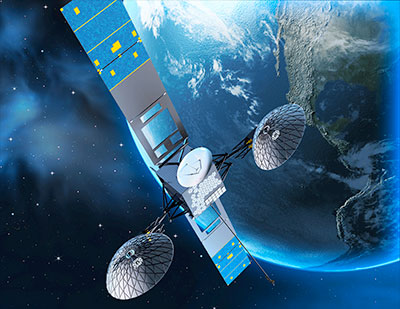
Above: This illustration depicts the NASA's Tracking and Data Relay Satellite, TDRS-M, in orbit. The TDRS system provides a communication vital link to the International Space Station, the Hubble Space Telescope and a host of Earth sciences satellites. (NASA)
Meanwhile, the Atlas V first stage booster and Centaur upper stage arrived aboard ULA's Mariner cargo ship at the Army Outpost wharf at Port Canaveral, Florida, June 27. The booster then was transported to the hangar at the Atlas Spaceflight Operations Center (ASOC), located south of Space Launch Complex 41. The Centaur moved to the Delta Operations Center, also at the Cape.
When preflight processing at the ASOC was complete, the Atlas V booster was raised in the Vertical Integration Facility (VIF) at pad 41 July 12 and the Centaur stacked on top a day later. After the TDRS-M satellite was readied in the Astrotech facility, it was encapsulated in its payload faring and transported to the VIF and mounted on the Centaur for final testing prior to launch.
Once in orbit the TDRS spacecraft will be positioned 22,300 miles above Earth and provide near-constant communication links between the ground and orbiting satellites.
"In today's world of instant data and communications requirements, it would be quite a task to rely on multiple space-to-ground relays using worldwide ground stations," Dunn said. "Fortunately we have TDRS today. The TDRS Network is a vital national asset."













